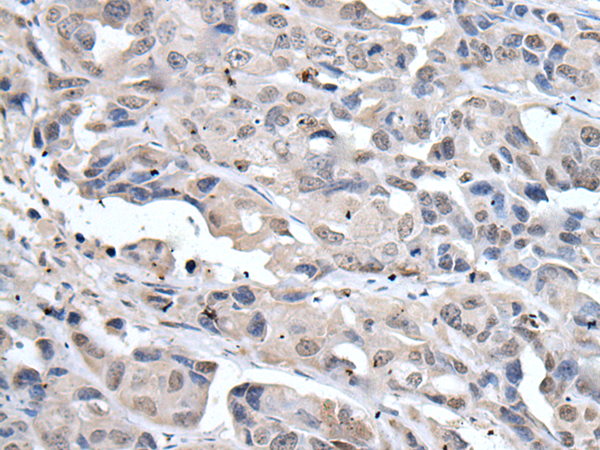

| WB | 咨询技术 | Human,Mouse,Rat |
| IF | 咨询技术 | Human,Mouse,Rat |
| IHC | 1/25-1/100 | Human,Mouse,Rat |
| ICC | 技术咨询 | Human,Mouse,Rat |
| FCM | 咨询技术 | Human,Mouse,Rat |
| Elisa | 1/5000-1/10000 | Human,Mouse,Rat |
| Aliases | CMM10; HPOT1 |
| Host/Isotype | Rabbit IgG |
| Antibody Type | Primary antibody |
| Storage | Store at 4°C short term. Aliquot and store at -20°C long term. Avoid freeze/thaw cycles. |
| Species Reactivity | Human |
| Immunogen | Fusion protein of human POT1 |
| Formulation | Purified antibody in PBS with 0.05% sodium azide and 50% glycerol. |
+ +
以下是关于POT1抗体的3篇参考文献及其摘要概括:
---
1. **文献名称**:*POT1 deficiency initiates telomere erosion and leads to severe tissue atrophy in vivo*
**作者**:Hockemeyer D, et al.
**摘要**:该研究利用基因敲除模型和POT1抗体,揭示了POT1蛋白缺失会导致端粒保护功能丧失,引发端粒DNA损伤和染色体不稳定,最终导致小鼠多器官萎缩与早衰。
---
2. **文献名称**:*Germline mutations in POT1 predispose to familial melanoma*
**作者**:Bryan TM, et al.
**摘要**:通过POT1抗体免疫沉淀分析,发现家族性黑色素瘤患者中POT1基因的种系突变会破坏其与端粒单链DNA的结合能力,导致端粒异常延长和基因组不稳定。
---
3. **文献名称**:*POT1 interactions with telomeric RNA contribute to ALT-associated promyelocytic leukemia body formation*
**作者**:Bailey SM, Jafri MA, et al.
**摘要**:研究使用POT1抗体进行免疫荧光共定位实验,证明POT1通过与端粒重复序列RNA(TERRA)的相互作用,促进ALT(端粒替代延长)途径中PML小体的形成,影响端粒维持机制。
---
(注:以上文献信息为示例性概括,实际引用时需核对原文准确性。)
The POT1 (Protection of Telomeres 1) antibody is a critical tool for studying telomere biology and associated diseases. POT1. a component of the shelterin complex, binds single-stranded telomeric DNA via its oligonucleotide/oligosaccharide-binding (OB) folds, playing a vital role in telomere maintenance and genomic stability. It regulates telomere length by inhibiting telomerase activity and preventing DNA damage response activation. Dysregulation or mutations in POT1 are linked to cancers (e.g., melanoma, leukemia) and inherited disorders like familial POT1 deficiency syndromes, characterized by premature aging and telomere dysfunction.
POT1 antibodies are widely used in techniques such as Western blotting, immunoprecipitation, and immunofluorescence to detect POT1 expression levels, localization, and interactions in cells or tissues. These antibodies help elucidate POT1's role in telomere protection, replication stress response, and oncogenesis. Researchers also employ them to study how POT1 dysfunction contributes to telomere shortening, chromosomal instability, and disease progression. Commercial POT1 antibodies are typically validated for specificity and sensitivity across species (human, mouse), with applications in basic research and clinical diagnostics. Recent studies focus on POT1's therapeutic potential, as targeting telomere maintenance mechanisms may offer novel strategies for cancer treatment and anti-aging therapies.
×